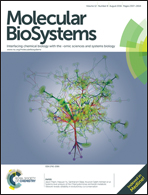Substrate transport pathway inside outward open conformation of EmrD: a molecular dynamics simulation study
Abstract
The EmrD transporter, which is a classical major facilitator superfamily (MFS) protein, can extrude a range of drug molecules out of E. coil. The drug molecules transport through the channel of MFS in an outward open state, an important issue in research about bacterial drug resistance, which however, is still unknown. In this paper, we construct a starting outward-open model of the EmrD transporter using a state transition method. The starting model is refined by a conventional molecular dynamics simulation. Locally enhanced sampling simulation (LES) is used to validate the outward-open model of EmrD. In the locally enhanced sampling simulation, ten substrates are placed along the channel of the outward-open EmrD, and these substrates are sampled in the outward-open center cavity. It is found that the translocation pathway of these substrates from the inside to the outside of the cell through the EmrD transporter is composed of two sub-pathways, one sub-pathway, including H2, H4, and H5, and another sub-pathway, including H8, H10, and H11. The results give us have a further insight to the ways of substrate translocation of an MFS protein. The model method is based on common features of an MFS protein, so this modeling method can be used to construct various MFS protein models which have a desired state with other conformations not known in the alternating-access mechanism.


 Please wait while we load your content...
Please wait while we load your content...